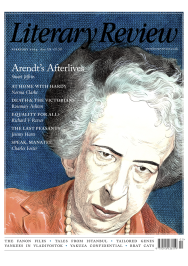Bijan Omrani
Pillars of Sand
The Seven Wonders of the Ancient World
By Bettany Hughes
Weidenfeld & Nicolson 416pp £25
The subject of this book is catnip for melancholics. There is no better spur for contemplating the vanity of human ambition than thinking on the fates of the Seven Wonders of the Ancient World. Bettany Hughes certainly does not omit to describe the thousand shocks, natural or otherwise, suffered by the wonders: the wrenching of the silvery limestone casing stones from the Great Pyramid at Giza to build medieval Cairo; the earthquakes, fires, invasions by Goths and Scythians, Christian vandalism, Byzantine looting and Sasanian conquest which combined to lay low the Temple of Artemis at Ephesus. Yet in explaining what the Seven Wonders meant to the ancients and how memories of them still affect us today, Hughes mitigates thoughts of their loss. The book is a meditation on the enduring idea of wonder, as well as being about the Seven Wonders themselves.
The first known list of the Seven Wonders dates to the second century BC. It is found in a fantastical dialogue between Alexander the Great and a group of Indian gymnosophists. This text, Laterculi Alexandrini, contains lists of sevens: the world’s seven most important islands, seven most beautiful rivers, seven best artists and so on. Such wonder lists became a subgenre for Greek and, later, Roman authors.
For the Greeks, these lists served as an encomium to the spread of Hellenistic culture across the known world following the conquests of Alexander, after which once-exotic regions were now within reach. They embodied the Hellenistic talent for taxonomy and empirical investigation which Aristotle nurtured in Alexander, who was his

Sign Up to our newsletter
Receive free articles, highlights from the archive, news, details of prizes, and much more.@Lit_Review
Follow Literary Review on Twitter
Twitter Feed
It wasn’t until 1825 that Pepys’s diary became available for the first time. How it was eventually decrypted and published is a story of subterfuge and duplicity.
Kate Loveman tells the tale.
Kate Loveman - Publishing Pepys
Kate Loveman: Publishing Pepys
literaryreview.co.uk
Arthur Christopher Benson was a pillar of the Edwardian establishment. He was supremely well connected. As his newly published diaries reveal, he was also riotously indiscreet.
Piers Brendon compares Benson’s journals to others from the 20th century.
Piers Brendon - Land of Dopes & Tories
Piers Brendon: Land of Dopes & Tories - The Benson Diaries: Selections from the Diary of Arthur Christopher Benson by Eamon Duffy & Ronald Hyam (edd)
literaryreview.co.uk
Of the siblings Gwen and Augustus John, it is Augustus who has commanded most attention from collectors and connoisseurs.
Was he really the finer artist, asks Tanya Harrod, or is it time Gwen emerged from her brother’s shadow?
Tanya Harrod - Cut from the Same Canvas
Tanya Harrod: Cut from the Same Canvas - Artists, Siblings, Visionaries: The Lives and Loves of Gwen and Augustus John by Judith Mackrell
literaryreview.co.uk